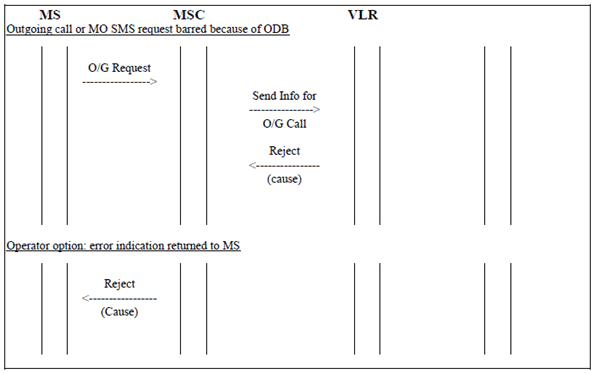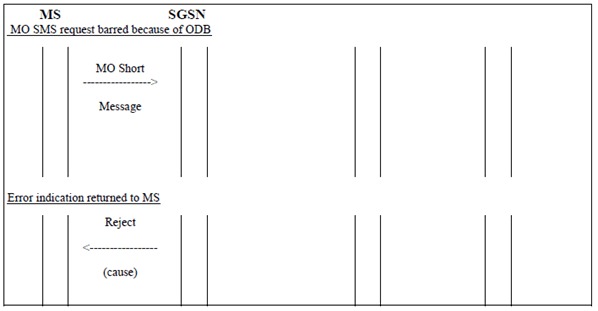Content for TS 23.015 Word version: 19.0.0
2 Method of realisation
2.1 Barring of Outgoing Calls or Mobile Originated Short Messages
2.1.1 Application or Change of Barring in the HLR
2.1.2 Invocation of Barring
...
...
2 Method of realisation p. 7
The entities which control the application of Operator Determined Barring (ODB), and the methods used, are described in this clause. Two cases are considered for each type of barring: the effect of administrative action in the HLR to modify the application of the category to a particular subscription, and the effect of the category on the handling of calls or other traffic involving the subscriber.
2.1 Barring of Outgoing Calls or Mobile Originated Short Messages p. 7
Barring of outgoing calls or mobile originated short messages includes the categories "outgoing calls" and "outgoing premium rate calls" defined in TS 22.041, and the "operator specific barring" category where this is defined by the PLMN operator to apply to outgoing calls or mobile originated short messages.
2.1.1 Application or Change of Barring in the HLR p. 7
If barring of outgoing calls or mobile originated short messages is applied to a subscription (or existing barring of outgoing calls or mobile originated short messages is modified or removed) by administrative action in the HLR, the HLR will update the subscription information accordingly, and transfer the updated subscription information to the VLR and the SGSN using one or more Insert Subscriber Data operations, as shown in Figure 2.1.1-1.
If operator specific barring is applied to a subscription (or existing operator specific barring is modified or removed) by administrative action in the HLR, the HLR will update the subscription information accordingly. If the mobile subscriber is registered in the home PLMN, the HLR will transfer the updated subscription information to the VLR and the SGSN using one or more Insert Subscriber Data operations, as shown in Figure 2.1.1-1.
If the VPLMN does not support Operator Determined Barring of outgoing calls, the VLR and the SGSN shall indicate this in the acknowledgement of the Insert Subscriber Data message. The HLR shall then, as an operator option, apply the Outgoing Calls Barred supplementary service, apply barring of roaming as described in clause 2.3 or take any other action decided by the operator of the HPLMN.

Figure 2.1.1-1: Transfer of updated subscription information to VLR or SGSN
(⇒ copy of original 3GPP image)
(⇒ copy of original 3GPP image)
2.1.2 Invocation of Barring p. 7
Barring of outgoing calls or mobile originated short messages is invoked in the VLR. If the VLR receives a request for subscription information for an outgoing call or mobile originated short message which is prohibited by Operator Determined Barring, the VLR will return a negative response to the request for subscription information, with an appropriate error indication. The MSC may relay this error indication via the BSS/RNS to the mobile station over the radio path, or (in the case of an outgoing call) may connect the mobile station to an address to be determined by the network operator.
Barring of mobile originated short messages is invoked in the SGSN. If the SGSN receives a request for a mobile originated short message which is prohibited by Operator Determined Barring, the SGSN will return a negative response to the request with an appropriate error indication via the BSS/RNS to the mobile station over the radio path.
Barring of all international calls, barring of all international calls except those directed to the home PLMN country, barring of all premium rate (information) calls or barring of all premium rate (entertainment) calls requires the VLR or the SGSN to analyse the called number to determine whether the requested call is barred.
Barring of all outgoing calls when roaming outside the home PLMN country requires the HLR to determine whether a request for location updating originates from a PLMN outside the home PLMN country. If the request does originate from a PLMN outside the home PLMN country, the HLR will transfer subscription information to the requesting node to indicate that the mobile station is subject to barring of all outgoing calls.
Operator Specific Barring may apply to outgoing or incoming calls, or mobile originated or mobile terminated short messages; if it applies to outgoing calls or mobile originated short messages, it is invoked in the VLR or the SGSN, as described above. If the barring applies to calls directed to a specific class of destination, the called number must be analysed to determine whether the requested call is barred.
Indicative message flow diagrams for the handling of Operator Determined Barring of outgoing calls or mobile originated short messages are given in Figure 2.1.2-1 and Figure 2.1.2-2. For the case where the mobile station is connected to an address determined by the network operator, this address is assumed to be directly connected to the MSC, so that no inter-MSC signalling is required.

Figure 2.1.2-1: Operator Determined Barring of Outgoing Calls or Mobile Originated Short Messages invocation in the VLR
(⇒ copy of original 3GPP image)
(⇒ copy of original 3GPP image)

Figure 2.1.2-2: Operator Determined Barring of Mobile Originated Short Messages invocation in the SGSN
(⇒ copy of original 3GPP image)
(⇒ copy of original 3GPP image)